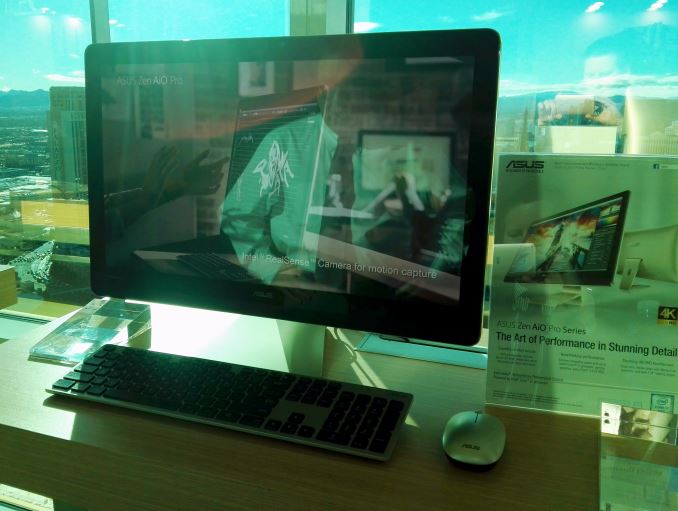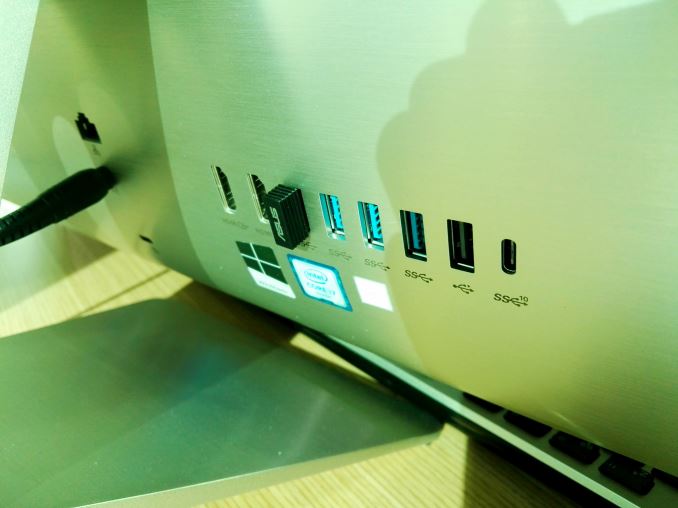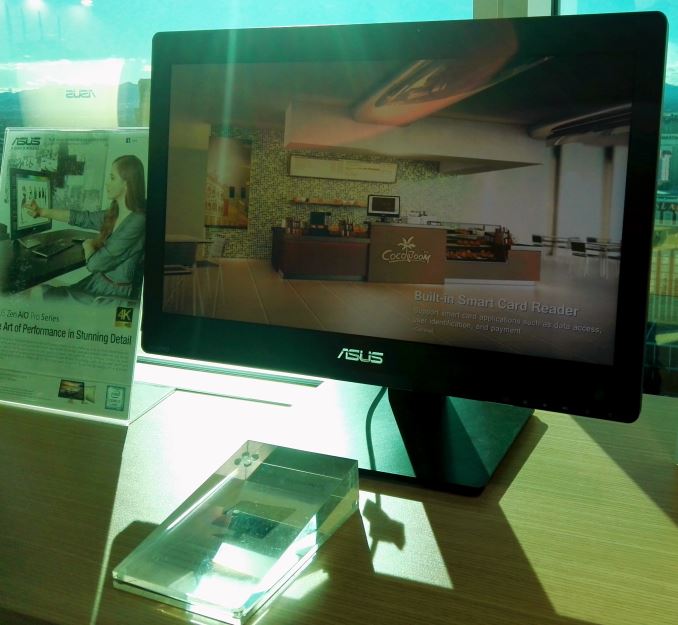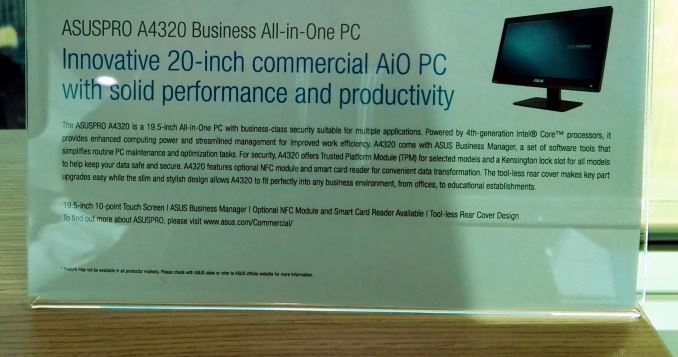ASUS Booth Tour at CES 2016: 10G Switches, External GPU Dock, USB-C Monitor and more
by Ian Cutress on January 19, 2016 9:00 AM ESTWith every passing show, we are seeing more and more all-in-one computers on display. I’m not knocking the form factor, but in my anecdotal evidence I do not see that many being used. Speaking to some of the AIO manufacturers, a lot of customers are actually business related, or related to certain vertical markets such as health, sales, education or manufacturing. As a result, we tend to see product categories like AIOs have very specialized design endpoints that meet certain requirements based on performance, style, particular features, or most importantly cost. Step in the Zen Pro AIO.
AIO goes Zen Pro
Zen is ASUS' premium style brand. We’ve seen Zen feature most prominently in products like the ZenFone, the Zen Watch and Zen Pad. If I recall correctly, back in Computex we saw the first generation of Zen monitors/all-in-ones ready to go. For CES, ASUS had the latest AIO model on hand.
It is quite clear what market ASUS is going for here – the iMac crowd. Everything about the Zen Pro is designed to be premium – the panel (up to 4K), the aluminium frame and finish, the RealSense Camera, support for USB 3.1, discrete graphics, raw CPU horse power, lots of memory and storage, and probably a kitchen sink as well.
The lack of clutter is an important point here, so we get similarly styled wireless mice and keyboards that work through nano-receivers on the rear panel and high quality WiFi internally. The model on display was the Z220IC, which is a 22-inch Full HD version, but there is also a Z240IC which has an optional UHD display. The Intel RealSense 3D camera is also available for Windows Hello facial login.
Next to the Zen AIO was a more conservative business focused model, with primary applications in the education and retail markets. The ASUSPRO model is a 20” AIO designed for commercial applications, and it can include a smartcard reader, VGA port, COM port, HDMI, and a tool-less back cover to access the internal components. There was nothing flashy about this model, but it certainly should fit the bill for specific instances where things like a COM port are necessary.















50 Comments
View All Comments
DanNeely - Tuesday, January 19, 2016 - link
Is the back of that phone actually made up of a bunch of triangular panels at angles to each other; or does the finish just fake the look?WorldWithoutMadness - Tuesday, January 19, 2016 - link
It is 3D (source http://www.androidcentral.com/hands-asus-zenfone-2...Panzerknacker - Tuesday, January 19, 2016 - link
I just dont understand why did 10G never become mainstream and is it so damn expensive? Back when 100mbit was mainstream the price of 1G was higher but nowhere near $760 for a switch. 1g is now mainstream for a decade or so, what takes it so long? Did we reach the limit of copper networking? I mean, in datacenters there has to be a enormous market for fast networking, I cannot understand why prices are still so high because on a huge market you would expect a lot a competition and fast development of hardware. Or did they completely move to different networking standards in datacenters, like fibre?Reflex - Tuesday, January 19, 2016 - link
Power consumption is very high compared to gigabit, and wireless replaced ethernet for most home and small office use, thus negating economies of scale which normally would drive prices down.Lieuchikaka - Thursday, June 2, 2016 - link
http://mavangvn.vn/ma-vang-dien-thoai/dien-thoai-s...TwistedKestrel - Tuesday, January 19, 2016 - link
It's mostly the ubiquity of 1GbE vs the handful of vendors making 10GbE parts. 1GbE PHYs are cheap as dirt, and 10GbE is two orders of magnitude more expensive... and there aren't that many people that want it yet. Once 1Gb+ throughput on 802.11ac radios becomes more commonplace instead of mostly theoretical, that would be something of a driver for consumer 10GbE.Interesting that a few US ISPs have upcoming or available service in excess of 1Gb, I wonder what kind of connections their equipment would have
DanNeely - Tuesday, January 19, 2016 - link
For consumer service, I'd be really surprised if it was anything but a combined modem/pretend it actually is able to achieve multi-gigabit speeds wifi router.iwod - Tuesday, January 19, 2016 - link
They have new standard NBase-T which provides 2.5Gbps and 5Gbps on Normal CAT 6 Cable. But no idea why no company are getting products out.Alex_M - Wednesday, January 20, 2016 - link
The real benefits for NBase-T will be 2.5/5 Gbps over exisitng Cat5e (not Cat6) upto 100m. It means we don't have to replace all those existing cable runs to benefit from the higher speed. Its fairly new but I hear that the silicon has started sampling....Lieuchikaka - Thursday, June 2, 2016 - link
http://mavangvn.vn/ma-vang-dien-thoai/dien-thoai-s...